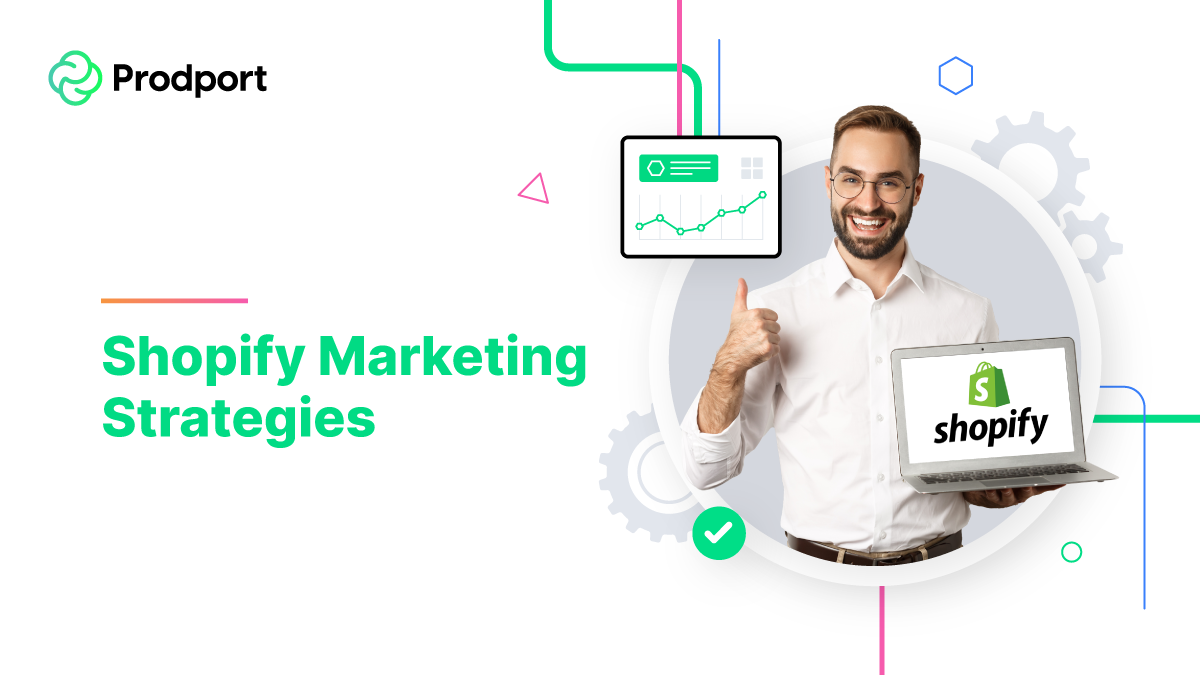You’re not here for a basic rundown of Shopify marketing strategies. You’re here because you understand that in the competitive e-commerce market, good isn’t good enough.
This guide is your compass. We’re going to cover various effective marketing strategies – some you might be familiar with, others that might be completely new to you. But each one holds the promise of taking your ecommerce store to new heights.
Strategy 1: The art of customer retention
The saying goes: “It’s not about getting customers, it’s about keeping them.” In the digital age, where options are endless, a loyal following for your Shopify store is gold.
And while attracting new faces is essential, there’s something incredibly powerful about recognizing the familiar ones. It’s about turning that first-time buyer into a regular – someone who doesn’t just browse but also stops for longer.
But, the real reason is that customer retention is more cost-effective than customer acquisition. (Forbes)
Start by getting to know the data. With Shopify’s analytics, you can easily identify your most loyal customers. Each click, each purchase, each return – it’s a chapter of their journey with your brand. Understanding this narrative will help you create memorable experiences.
Don’t just shower them with rewards. Memories last longer. Introduce a loyalty program for your Shopify store that isn’t just about points but about experiences. Maybe after a certain number of purchases, they get a behind-the-scenes look at how new products are sourced or made. Or perhaps they get to be part of an exclusive community where they have a say in upcoming product lines.
Think of brands like Ben & Jerry’s, which offer factory tours, giving loyal customers a delightful peek into the ice-cream-making process.
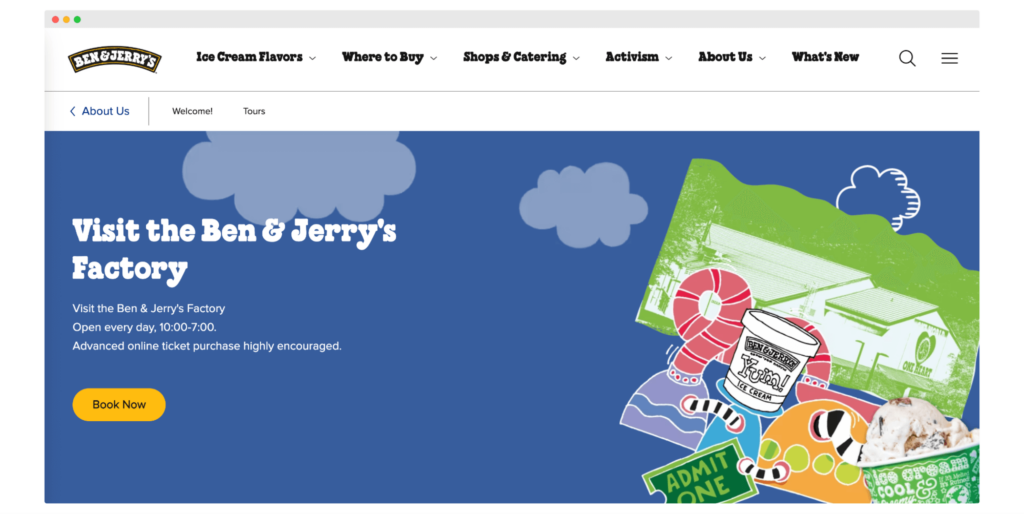
And also – to keep loyal customers loyal, always be open to feedback. Create channels where customers can voice their opinions, concerns, and suggestions. And, more importantly, act on this feedback. Such a proactive approach not only solves issues but also showcases your commitment to customer satisfaction.
Strategy 2: Enhanced checkout experience
Imagine this: A customer finds the perfect product in your store, adds it to their cart, and just when they’re about to make the purchase, they abandon it. Frustrating, right? The checkout process is where many stores lose potential online sales. But with a few tweaks, it can be where you shine the brightest.
Simplicity is key. The more hoops a customer has to jump through, the higher the chances they’ll abandon their cart. Streamline the process. If possible, reduce it to a single page. Offer a guest checkout option. Not everyone wants to create an account, and that’s okay.
Tip! Implement Shopify’s Dynamic Checkout Buttons for a one-click payment process. It enables branded payment methods, such as Apple Pay or Shop Pay.

Trust is also a significant factor during checkout. Display security badges prominently. Offer a clear and fair return policy and ensure it’s easily accessible during checkout. These small trust signals can make a massive difference in conversion rates.
Strategy 3: The power of Gift Guides
Gift guides have become commonplace in e-commerce, especially during the holiday season.
But why limit them to just that? Birthdays, anniversaries, graduations – there are countless occasions year-round when shoppers are looking to buy the perfect gift.
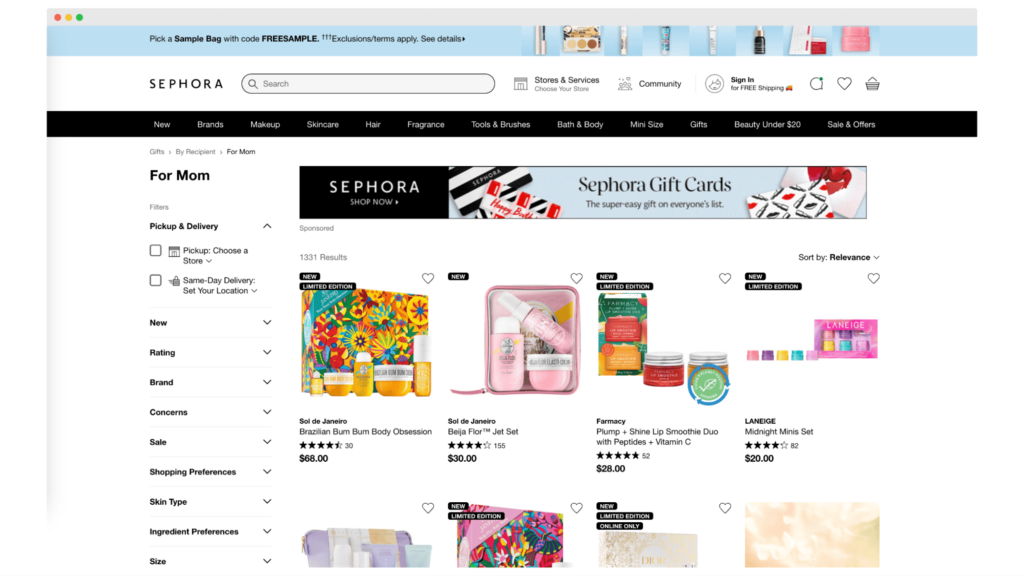
Gift guides can serve as a sales funnel. They not only help customers find products within their budget but also introduce them to products they might not have considered before. It’s also a powerful tool to drive traffic to your Shopify store.
You can create various guides like “Sustainable Gifts,” “Tech Gifts,” or “Gifts Under $20” to appeal to different customer needs. Get your bestsellers together and boost their sales even more.
Strategy 4: Shopify Apps as digital marketing boosters
Ever felt like a kid in a candy store, eyes wide, not knowing where to start? That’s the Shopify App Store for many – packed with tools, each promising to skyrocket your ecommerce marketing activities. But with so much choice, how do you pick the best Shopify apps that align with your store’s needs?
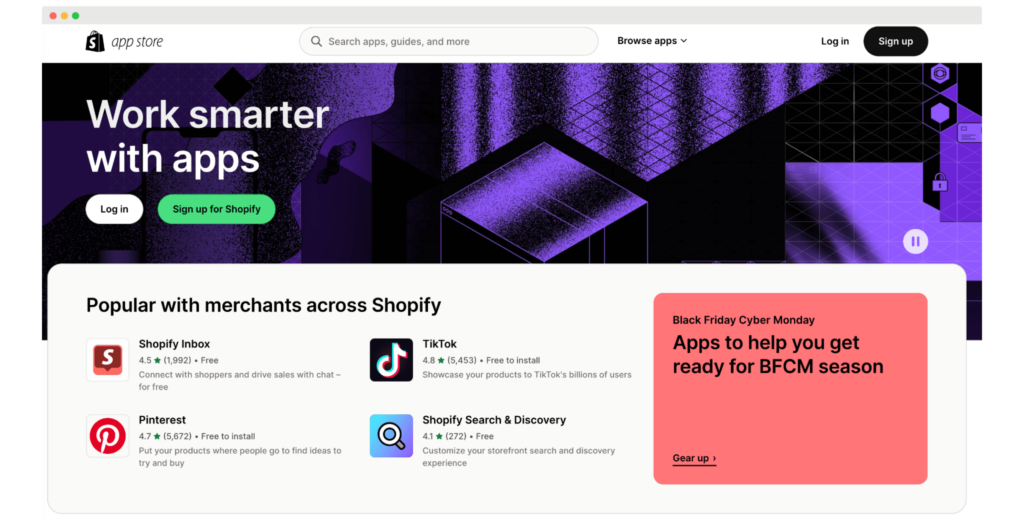
Here are some worth checking out.
- Pop-up perfection: Want to craft eye-catching pop-ups without the tech headache? Check out a marketing app like EcomSend. With its drag-and-drop editor, you can whip up customized pop-ups, perfect for snagging visitor emails or spotlighting special deals.
- Email Marketing: If emails are your game, apps like Klaviyo and Omnisend are your greatest hits. From segmenting your audience to crafting automated campaigns, these apps ensure your messages hit the mark every time.
Remember that the Shopify App Store is like the universe – ever-expanding. New apps pop up, addressing the fresh challenges and opportunities of e-commerce. Don’t miss out on these opportunities.
Strategy 5: “Buy Now, Pay Later” as a modern convenience
The Buy Now, Pay Later (BNPL) option has gained significant popularity recently. Flexibility in payment has become a significant player in the strategy for a Shopify store. Services like Afterpay and Klarna have reshaped the checkout process. They offer consumers the luxury of time to complete their payments.

It’s worth thinking about. Offering the BNPL feature can increase your average order value and attract a broader customer base. (Shopify)
These options can increase sales in a tangible way. When customers realize they can distribute their payments without immediate financial strain, they’re more inclined to finalize their purchase. It’s not uncommon for shoppers to add a few more items to their cart when they know they have the flexibility of spaced-out payments.
Strategy 6: Personalized shopping experience with Prodport
Imagine a scenario where every time a shopper visits your store, they feel seen, understood, and listened to. It’s like walking into a boutique where the owner knows your style, preferences, and even your mood for the day. A tool like Prodport enables Shopify store owners to deliver that.
With Prodport, you can create product pages that adapt in real time to each shopper’s preferences. Presenting products in a way that resonates with individuals.

Kahlmi has experienced a significant increase in conversions and add-to-cart rates thanks to Prodport. Elina Furman from Kahlmi mentions:
“It’s amazing how seamless it is. I can change my product page in basically 5 seconds and test different versions to see which one converts better.”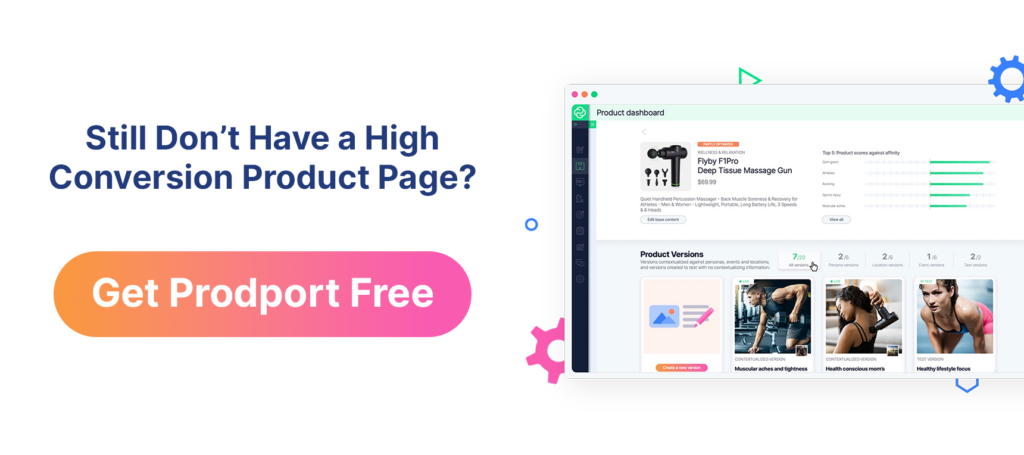 Such personal touches can transform casual browsers into loyal customers. This level of personalization can also significantly boost conversions. It enhances customer satisfaction, as shoppers are more likely to find products that truly interest them.
Such personal touches can transform casual browsers into loyal customers. This level of personalization can also significantly boost conversions. It enhances customer satisfaction, as shoppers are more likely to find products that truly interest them.
Strategy 7: Social proof through reviews
What better way to build trust than through authentic reviews? They become the silent salespeople of the online world. They whisper assurances, share experiences, and sometimes, they even shout out warnings.
For store owners, these reviews are priceless. Social proof in the form of reviews or testimonials can significantly influence a customer’s buying decision.
How to encourage the customers to leave feedback? Motivating happy customers to share their stories can be as simple as offering a small token of appreciation, like a discount on their next buy. And when they do share, you can use it in your marketing materials.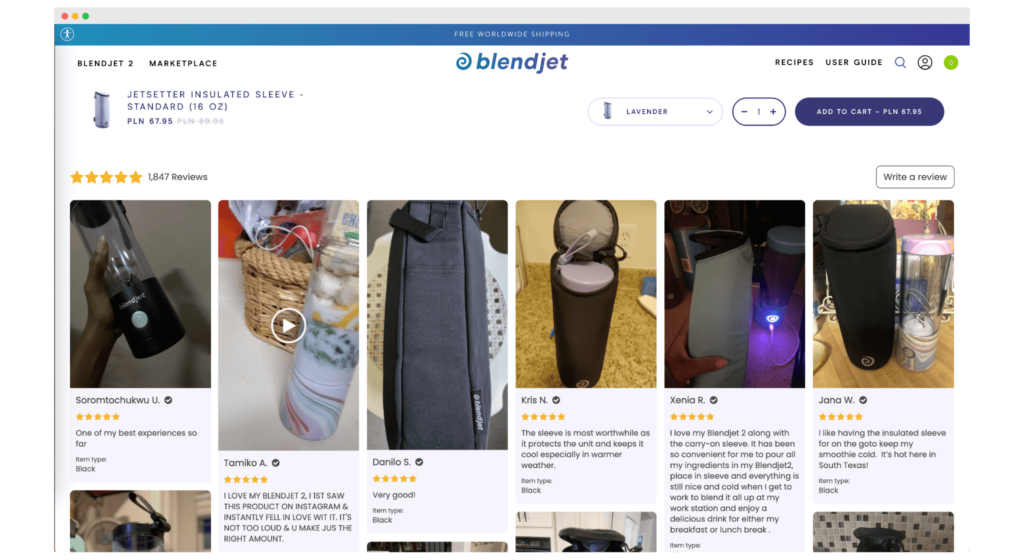
Apps like Loox let your customers share their opinions with photos on your Shopify store. It’s authentic, it’s relatable, and it’s a powerful motivator for potential buyers (despite not being the most aesthetic option).
But not all stories have happy beginnings.
Negative reviews, though initially a sting, can be turned around. Address them promptly, offer solutions, and showcase your brand’s dedication to continuous improvement. Potential customers often read negative reviews to see a company’s responsiveness and integrity.
Strategy 8: Content marketing beyond the blog
Content is more than just words on a page or visuals in a feed. It’s the heart and soul of your e-commerce brand, and with the right overall marketing strategy, it can turn your Shopify store into a magnet for traffic.
- Videos – do you know that awesome feeling when you see a product and think, “I’ve got to have that!”? Videos can do that. Think about showcasing how your products are made or maybe a happy customer sharing their joy. It’s like giving your online visitors a virtual tour of your store, making them feel right at home.
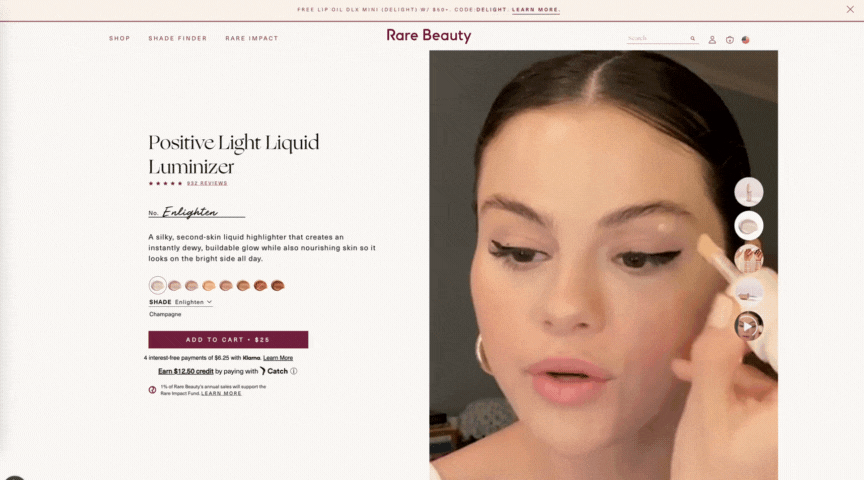
- Infographics – got a product with a cool backstory? Or maybe a process that sets you apart? Lay it out in an infographic. It’s like those fun, informative posters but for the online crowd. For instance, if you’re all about sustainable products, a neat infographic can show your eco-friendly journey, making your customers feel good about their purchase.
- Podcasts – remember those radio shows where people would share stories, tips, or just chat about their favorite things? Podcasts are the modern version. Maybe it’s a chat with someone who loves your product or discussions about the latest trends in your niche. It’s a way to keep your customers engaged, even when they’re on the move.
Adding a variety of content to your site can improve your SEO rankings, making your store more visible to potential customers. And guess what? Your community loved it, leading to more engaged customers and, of course, more sales.
Strategy 9: Email marketing as a silent powerhouse
While social media platforms come and go, email remains a constant. It’s personal, direct, and, when done right, incredibly effective. But in an age of overflowing inboxes, how can your brand’s emails stand out?
Segmentation is your best friend. Not all customers are the same, so why send them the same email? Group your ecommerce store subscribers based on their preferences, purchase history, or even how often they engage with your emails. Tailored content resonates more, leading to higher open and conversion rates.

Automation is something that can transform your email marketing campaigns. Welcome sequences for new subscribers, cart abandonment reminders, or even birthday discounts can be a part of automated email marketing. Such an email marketing tool as Mailchimp can take care of timely and relevant communication.
Tip! Always prioritize value over sales pitches. Whether it’s exclusive content, early access to sales, or even educational material related to your products, adding value ensures your emails are eagerly anticipated rather than quickly deleted.
Strategy 10: Flash sales and limited-time offers
There’s something thrilling about a flash sale. The ticking clock, the limited stock, the unbeatable prices – it’s a recipe for excitement and, more importantly, sales.
But how can you ensure your flash sale is a hit and not a miss?
Promotion is key. Tease the sale on your social media platforms, email newsletters, and even your website’s homepage. Build anticipation, ensuring your audience is eagerly waiting for the sale to go live.
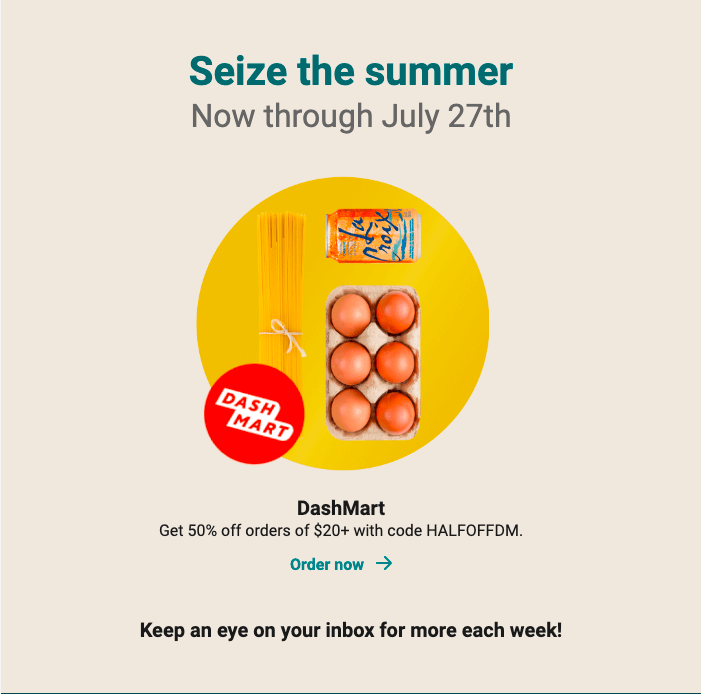
As the sale progresses, keep your audience in the loop. If certain items are running out or if new ones are added, let them know. This not only keeps the excitement alive but also pushes those who are on the fence to make a purchase.
Strategy 11: SEO the long game to digital visibility
With the vast expanse of the internet, where every Shopify store competes for attention, being on that desired first page is like having a prime storefront in the busiest part of town.
But here’s the thing. SEO isn’t a sprint. It’s a marathon. It’s not about quick wins but enduring success. And while paid ads might give you that instant spotlight, organic search results build trust. (Search Engine Journal)
Learn all about keywords. Understand what your potential customers are typing into that search bar. It’s like listening to a global conversation, picking up on trends, needs, and desires. Tailoring your Shopify store’s content to these keywords is like speaking your customer’s language.
But don’t just stop at keywords. Think about the user experience. A slow-loading page? That’s like a closed shop door. Broken links? They’re the bumps on the digital highway. Your Shopify store must provide a seamless, user-friendly experience.
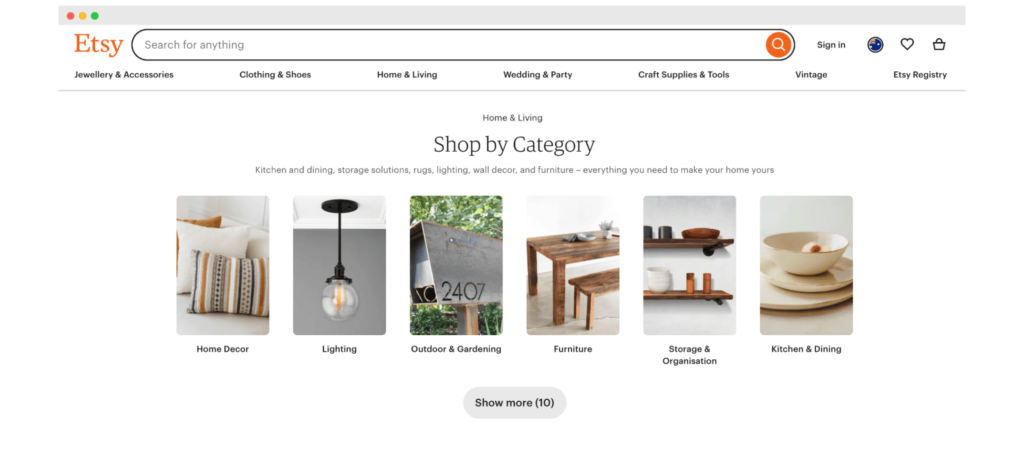
Consider brands like Etsy. There are more than listings on their site. There are stories, experiences, and dreams as well. And that’s why their platform often stands out in search results when you think of handmade, one-of-a-kind gifts.
Strategy 12: Community building via social media
Algorithms change, and platforms come and go, but one thing remains – genuine connection helps achieve marketing goals. Instead of flooding your followers with posts, why not share tales that echo your brand’s soul? Maybe it’s a customer’s heartfelt testimonial or a sneak peek into your daily operations.

And hey, talking shouldn’t be your sole social media marketing strategy. Listen. Reply to those comments, dive into discussions, and maybe even go live and chat with your community in real-time. Remember that collab with a local influencer? Or that giveaway you did with a brand that vibes with yours? That’s how you grow your community together.
Tip! Don’t forget to integrate your Shopify store with social media channels. Thanks to that, you can bring Shopify store visitors from Instagram or Facebook. You can sell your products directly from the Shop tab on your store’s Facebook page or by tagging them directly on Instagram posts.
Collaborate and expand your reach. Partner with influencers or other brands that align with your values. Joint promotions, giveaways, or even content swaps can introduce your brand to a wider audience while offering fresh content to your existing followers.
Strategy 13: Preparing for traffic spikes
Every store owner dreams of that boost in traffic, whether it’s from a successful marketing campaign, a viral post, or a holiday sale. But is your store equipped to handle it?
- Regularly test your site’s load capacity. Tools like Hyperspeed can simulate traffic surges, ensuring your site can handle the pressure. If there are any bottlenecks, address them promptly.
- Optimize your site’s performance. Compress images, leverage browser caching, and minimize HTTP requests. Every second counts, and in the online world, a delay of even a few seconds can lead to cart abandonment.
- Keep redirects to a minimum. Every redirect interrupts the shopping experience. In particular, keep them minimal during checkout.
For example, the Page Speed report can identify slow-loading pages that need optimization. Being prepared for these events can make the difference between a successful sale and a website crash. To see it on your Shopify store, go to Analytics > Reports > Online store speed.
Strategy 14: Affiliate marketing program for building partnerships
The goal of affiliate marketing is to create relationships to make enthusiasts into brand ambassadors. But, is it possible to create an affiliate program that is both effective and attractive?
Here’s the catch. To have the best ambassadors, you’ve got to offer the best incentives. Think of it as a partnership. Your brand’s horizons can be expanded by paying a top-notch commission.
Equip your allies. Hand them the banners, the crisp product shots, and the stories behind each product. Don’t forget that teamwork is just as important as the tools. Share sneak peeks of what’s next, host brainstorming sessions, or even just catch up over a virtual coffee.

Ever wondered why brands like Gymshark have such a strong affiliate presence? It’s because they don’t just see affiliates as promoters. They see them as partners.
Strategy 15: Gamification to make shopping fun
What better way to elevate the shopping experience on your Shopify website than by introducing elements of play? Gamification is one of the best marketing strategies to increase engagement and promote your Shopify store in a fun way.
Every purchase, review, or social media marketing channel like Instagram or Facebook can earn customers points in your loyalty program for your Shopify store. These points could unlock exclusive discounts, early access to sales, or even unique merchandise, driving more traffic to your Shopify store.
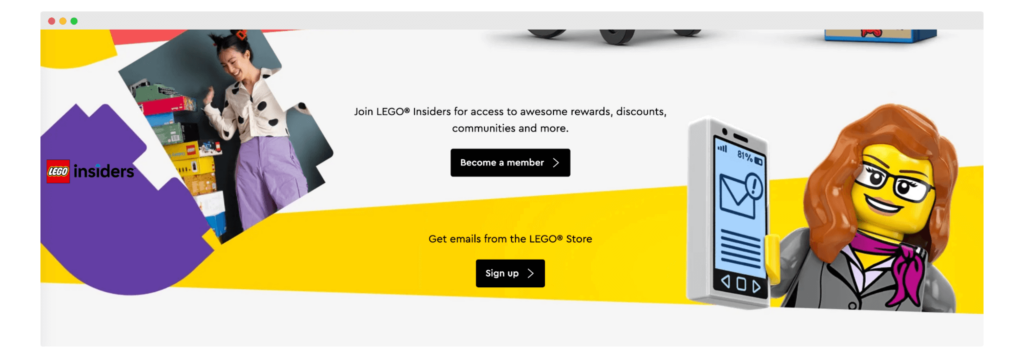
Maybe it’s a photo contest where customers showcase creative uses of your product, integrating social media marketing and word-of-mouth marketing. Or perhaps it’s a scavenger hunt across your site, with clues leading to hidden discounts. These challenges not only drive engagement but also create a buzz, fostering a loyal following for your Shopify store.
The good news is that Shopify makes it easy with various apps in the Shopify App Store designed for these purposes, e.g., Alia. Tools like these can significantly boost online sales and customer loyalty, as gamification increases customer interaction and encourages them to visit your store repeatedly.
Strategy 16: Cross-selling and upselling
A customer is browsing through your online store and stops at a camera. This is where cross-selling comes into play. Instead of just the camera, why not promote a bundle? A package that includes a camera case, memory card, and tripod.
Now, let’s talk about upselling, a powerful tool for Shopify store owners. It’s all about elevation. Say a customer is considering a basic skincare product. This is your chance to highlight the benefits of the premium version, which might have additional natural ingredients or offer faster results. But remember, it’s essential to prioritize the customer’s needs. Upselling should feel like you’re offering a better solution, not just a pricier one.
But here’s the beauty of it – with Prodport, it never feels intrusive. Their AI-driven platform understands user behavior, ensuring that every suggestion, every push, feels organic and personalized. It’s like having a conversation, not a sales pitch.
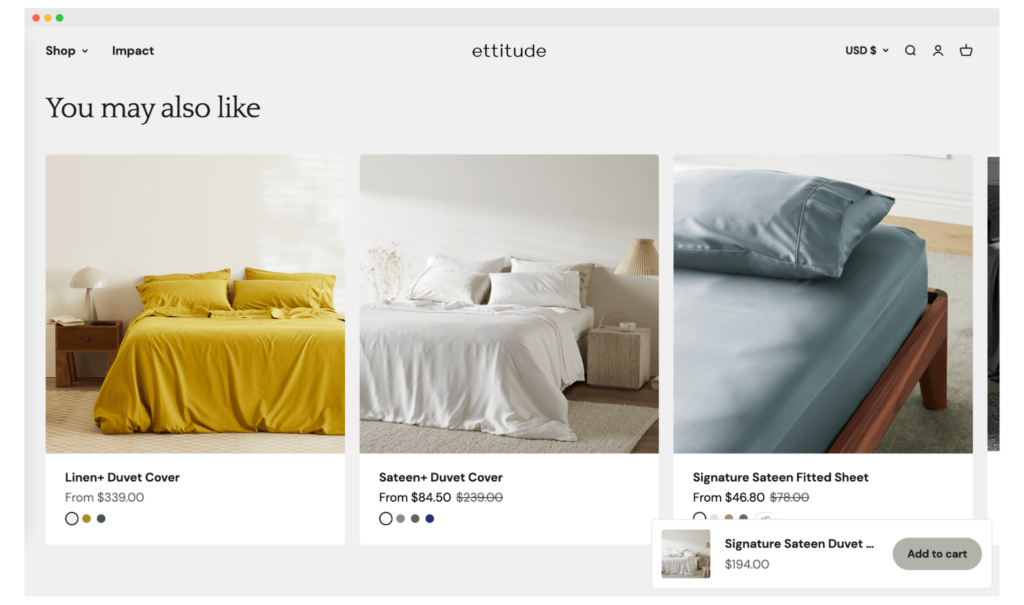
The platform allows you to rapidly deploy customized product images, titles, and descriptions that resonate with each shopper’s unique preferences. Best to start to make your visitors feel like they are the only ones in your store.
Strategy 17: Mobile optimization for the pocket-sized store
Responsive design is non-negotiable. Your store should look and function seamlessly across devices. If your Shopify site isn’t optimized for it, you’re missing out on a massive chunk of potential new customers.
A mobile-optimized site loads faster, ranks better on search engines and simplifies the user journey. The goal is to ensure that the process is as intuitive on mobile as on desktop, from product discovery to checkout.
Consider brands that have mastered the art of mobile optimization. Their sites feel like a natural extension of the mobile device, with intuitive swipes, clear call-to-action buttons, and easy navigation. Every element is designed with the mobile user in mind, ensuring that they don’t just browse but also buy.
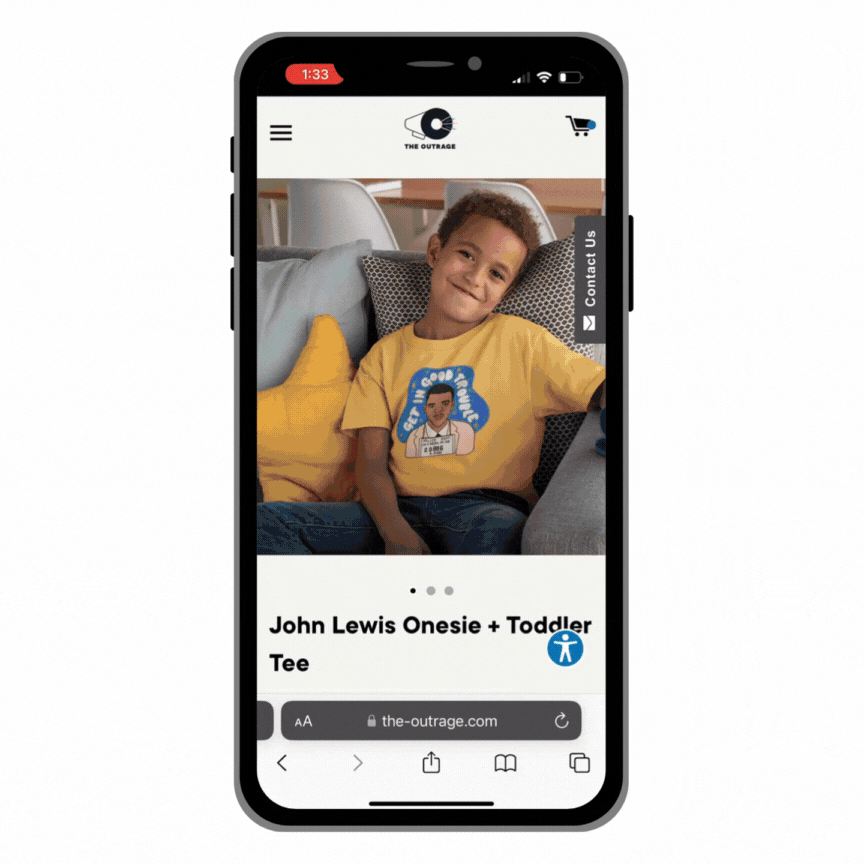
So, as you refine your Shopify marketing plan, remember – size doesn’t matter, but experience does. Ensure your store is ready for those on-the-go moments.
Strategy 18: A/B Testing as the science of choice
You’re torn between two marketing messages. One offers “free shipping,” while the other promotes an “exclusive influencer marketing collaboration.” Which one will resonate more with your audience? Which will drive more traffic to your Shopify store and increase sales? Instead of relying on guesswork, A/B testing gives you data-driven answers.
Here’s how it works.
You present two versions of a webpage (or an email marketing message or an SMS marketing campaign) to different segments of your audience. Over time, by analyzing which version performs better in terms of conversions, click-through rates, or any other metric, you can determine which strategy is more effective.
Maybe it’s testing the color of a call-to-action button, the phrasing of a product description, or even the layout of your homepage. By serving different versions to different users, you can gather data on what resonates most.
Strategy 19: Live Chat Support for real-time assistance
If your customers have questions about the features, shipping times, or return policies of a product, you should address them in real time to prevent cart abandonment.
Live chat is a dynamic marketing tactic, a direct line that lets you give the best customer experience. Live chat offers customers immediate answers, building trust and potentially sealing the deal.

Chatbot integrates with your Shopify store seamlessly if you remember these things:
- Position the live chat icon prominently, typically in the bottom right corner, so it’s easily accessible without being obtrusive.
- Ensure that customers receive a response within a few minutes. Delays can lead to lost sales or frustrated customers.
- Ensure the live chat feature is optimized for mobile users, given the increasing number of shoppers using smartphones.
- If 24/7 support isn’t available, clearly communicate the hours when live chat support is active.
- While canned responses can speed up the chat process, they should be used judiciously to avoid sounding robotic.
Tip! Consider chatbots for after-hours. While they cannot replace human interactions, they can address frequently asked questions, ensuring customers have access to information at all times.
Strategy 20: Geo-targeting for a local experience
The beauty of e-commerce is its borderless nature. A customer in Tokyo can effortlessly shop from a store based in New York. But with this global reach comes the challenge of adapting to diverse audiences. Geo-targeting offers a solution that allows you to tailor the shopping experience based on the customer’s location.
- Implement dynamic pricing based on the region. Factors like shipping costs, taxes, and even purchasing power can vary significantly across countries. By adjusting prices accordingly, you can ensure competitiveness in different markets.
- Localize content. Translating the language isn’t enough – you have to understand cultural nuances as well. Celebrate local holidays, highlight region-specific products, or even share stories that resonate with the local audience.
- Offer region-specific payment methods. While credit cards might be popular in one country, digital wallets or bank transfers might be the norm in another. By providing familiar payment methods, you reduce friction during the checkout process.
Geo-targeting allows you to show different content or offers based on the user’s location. This can be particularly useful for stores that ship internationally.
Strategy 21: Profitable subscription models
Subscription models can provide a steady income and improve customer retention – the things that are not so obvious in the changing e-commerce landscape.
A subscription model is a business strategy where customers pay a recurring fee (typically monthly or annually) to access a product. Instead of making a one-time purchase, customers commit to buying a product regularly, ensuring a consistent revenue stream for the business.
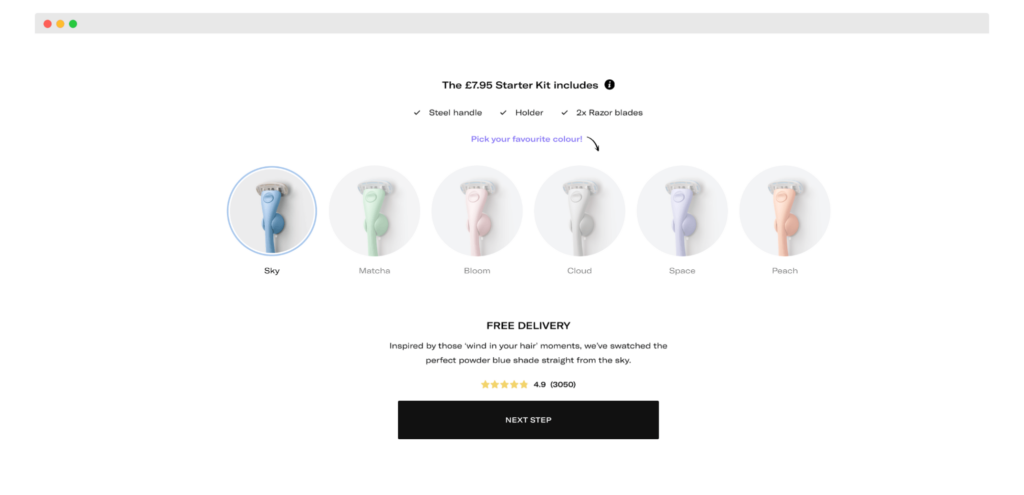
- Consider introducing a subscription box. Curate a monthly selection of products, offering subscribers a mix of bestsellers and new arrivals. It’s a delightful surprise for the customer and a guaranteed sale for you.
- Loyalty programs can complement subscription models. Offer subscribers exclusive perks like early access to sales, bonus loyalty points, or even freebies with every box. These perks enhance the perceived value, making customers more likely to stick around.
- Always offer flexibility. Whether it’s adjusting the frequency, pausing the subscription, or even customizing the contents of the box, flexibility can reduce churn rates. Remember, a subscription model thrives on long-term relationships, and flexibility fosters this longevity.
Conclusion
Marketing is one of the most dynamic fields out there. It’s essential to keep up with the latest Shopify marketing ideas and strategies used by top brands. And while inbound marketing can help draw customers in, it’s the owned marketing channel, like email marketing, that often seals the deal.
So, whether you’re looking to inspire your Shopify audience, increase traffic to your store, or simply refine your marketing tactics, remember this – one of the best ways to succeed is to stay informed, be adaptable, and always prioritize your customers.
